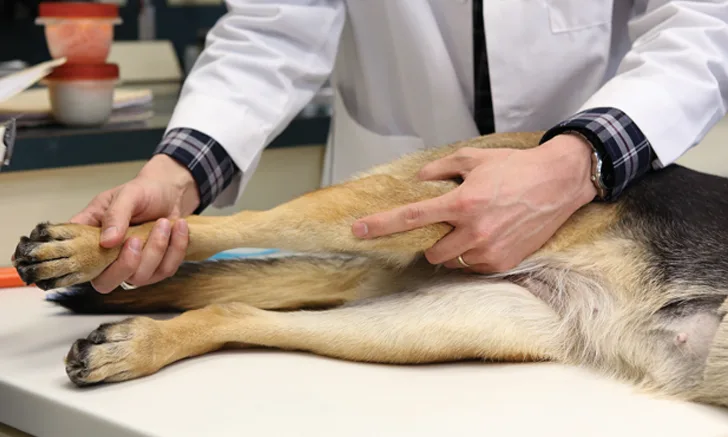Cranial Cruciate Ligament Disease in Dogs
Karl C. Maritato, DVM, DACVS (Small Animal), MedVet Cincinnati and MedVet Dayton

Proper hand positioning and technique for assessing cranial tibial thrust
Cranial cruciate ligament disease (CCLD) is caused by a gradual degeneration of the cranial cruciate ligament (CCL), which results in a partial or complete ligament tear. CCLD is the most commonly diagnosed disorder of the canine stifle joint1 and is the orthopedic disease most commonly treated surgically in practice.
Patients can present with a variety of signs; some are easily recognizable and easy to diagnose, while others are less obvious, making diagnosis more challenging.
The CCL serves 4 functions2:
Prevention of cranial tibial thrust (CTT)
Prevention of hyperextension of the stifle
Prevention of excessive internal rotation of the stifle
Proprioception
Tear or rupture of the ligament allows excessive movement in the stifle, causing lameness and pain. (See Table 1.)
Cranial Cruciate Ligament Signs
CCLD occurs in dogs of all sizes at different ages. (See Table 2.) Dogs that are female, obese, or older are at higher risk for CCLD.3,4 A genetic link has been documented in the Newfoundland breed that may also be present in other breeds.5
Related ArticlesTop 5 Tips for Postoperative At-Home CareTop 5 Most Common Orthopedic Conditions in DogsTaking the Lead on Orthopedic Examinations
Breeds Commonly Affected by CCLD
| Large4,16,17
Labrador retriever
Newfoundland
Rottweiler
| 2-6 years | Weight-bearing to non-weight-bearing lameness; pain on stifle hyperextension, palpable joint effusion, and stifle thickening | |
Small4,16,17
Bichon frise
West Highland white terrier
Yorkshire terrier
| <8 years | Can be associated with medial patellar luxation | |
Other16,17
Boxer
Mastiff
Pit bull terrier
| <2 years | Disease is often bilateral |
Diagnosis
Physical examination should include gait observation and careful orthopedic examination, including stifle palpation and manipulation.
Simple presentations of CCLD include high-grade lameness (ie, toe-touching lameness to non-weight-bearing lameness) with obvious cranial drawer (CD) and CTT.6 Evaluation of CD signs and CTT, which are diagnostic tests for CCLD, should be performed during examination. (See Figure 1 & Cranial Drawer & Cranial Tibial Thrust Tests.)
Cranial Drawer & Cranial Tibial Thrust Tests
Cranial drawer test
Place one hand on the distal femur with the thumb on the caudal aspect of the condyle and the index and middle fingers on the patella.
Place the thumb of the other hand on the fibular head and the index and middle fingers on the tibial tuberosity.
Slide the tibia cranial to the femur; if the tibia slides cranially, the CD is positive.
Place one hand on the distal femur.
Firmly flex the hock (talocrural joint) with the other hand, while maintaining a static angle of the stifle.
With positive CTT, the tibia translates cranially (ie, thrusts) relative to the femur during flexion of the tarsus; with complete CCL tears, a CCLD diagnosis is straightforward.
Place one hand on the distal femur with the thumb on the caudal aspect of the condyle and the index and middle fingers on the patella.
Place the thumb of the other hand on the fibular head and the index and middle fingers on the tibial tuberosity.
Slide the tibia cranial to the femur; if the tibia slides cranially, the CD is positive.
Place one hand on the distal femur.
Firmly flex the hock (talocrural joint) with the other hand, while maintaining a static angle of the stifle.
With positive CTT, the tibia translates cranially (ie, thrusts) relative to the femur during flexion of the tarsus; with complete CCL tears, a CCLD diagnosis is straightforward.
If ligament degeneration has been present for several months or longer, thickening of the medial aspect of the stifle joint, known as medial buttress, is likely present. This fibrous tissue forms to help stabilize the joint4 and can be palpated during orthopedic examination. All patients with CCLD will have pain on hyperextension of the stifle; in fact, this is likely the earliest finding on examination after the patient becomes lame.6
Approximately half of patients with CCLD will also have a torn medial meniscus. During stifle range of motion, a meniscal click may be heard, and these patients are typically painful on hyperflexion of the stifle joint.6-10
Chronic partial tears are more difficult to diagnose, as many patients with partial tears have negative or mild CD signs and CTT because of periarticular fibrosis. These patients often have a history of chronic, lower-grade lameness. Some degree of medial buttress may be palpable on examination, and hyperextension will elicit pain.5
Radiographs should be obtained in patients with suspected CCLD to aid in diagnosis, rule out other diseases, and plan for surgery. Sedation can aid in proper positioning. On radiographs, stifle joint effusion and osteophytosis of the patella, femur, and/or tibia can be seen.
Treatment
Most patients that receive appropriate postoperative care return to normal function within 3 to 6 months. Strict exercise restriction for 6 to 8 weeks is required following all surgeries to ensure proper healing without implant system failure. An E-collar is recommended while the incision is healing because stifle surgeries have a higher than average postoperative infection rate and patients tend to lick and chew their incisions.
Conclusion
It is imperative that clients whose dogs have CCLD understand the following:
Surgery is required to achieve the most optimal outcome.
Postoperative care rules must be followed to minimize complications and help ensure a successful outcome.
Full recovery takes months.
Even with surgery, varying degrees of arthritis will still be present.
CCLD is commonly diagnosed in a variety of breeds and can be successfully treated surgically, but client understanding and compliance is paramount to success.